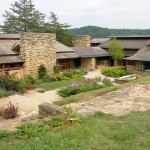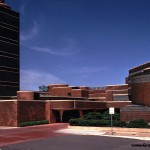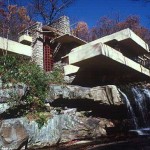Many consider Frank Lloyd Wright to be the greatest architect of all time. And who can blame them? Wright’s name is as synonymous with greatness as Jimmy Hendrix and Michael Jordan. He is widely recognized as the father of modernism, a true visionary and the leading figure in all things architecture. Atlas Signs and Plaques is based in Wisconsin–Frank Lloyd Wright’s birthplace. As such we support a healthy number of signs and plaques created in the style of his architecture. All of these signs feature crisp, hard lines that accentuate the subtle brilliance of simple, effective design. If you are a fan of Frank Lloyd Wright (and why wouldn’t you be) then perhaps a Frank Lloyd Wright Address Sign is wright for you. Follow this link to view our selection of Frank Lloyd Wright style signs and plaques.
Just for fun I’m going to show you the best 5 Frank Lloyd Wright creations including what I consider the finest building ever constructed on American soil.
#5) The Monona Terrace, Madison, WI, 1997
This building was initially proposed by Wright in 1938 and was conceived as a “Dream Civic Center”. The design was rejected by Madison’s city council with a margin of a single vote. Sixteen years later the board approved the construction of a new civic center and elected Wright as its architect. Wright stated that being chosen as the project’s architect by the people of Madison meant much more to him than any award. Sadly, any progress on the building was halted because of the United States’ involvement with WWII. In 1992, after years of contests and delays, Madison’s new civic center was approved for construction. In 1997, 59 years after its inception, the Monona Terrace was finally open.
#4) Taliesin, Spring Green, Wisconsin, 1911
The Taliesin studio house was built shortly after Wright left his first wife Catherine Tobin. Alongside idiosyncratic design, this house is famous for being the site of two fires. The first fire was a heinous murder scene where worker-servant Julian Carlton locked residents of the house inside, set the house ablaze, and waited outside the front windows with an axe. The second fire was likely caused by a lightning surge through the house’s telephone line. The third iteration has thankfully been fire-free.
#3) Hollyhock House, Los Angeles, California, 1922
The hollyhock house was commissioned by wealthy oil heiress/actress Aline Barnsdall. Barnsdall told Wright that she wanted the house designed with “the progressive theatrical community” in mind. The result is one of Wright’s most visually unique creations. After maintenance costs overwhelmed Barnsdall she donated it to the city of Los Angeles under the stipulation that it be used as the headquarters for the California Art Club for 15 years. Though that lease has long ended, the house is still a popular tourist attraction.
#2) Johnson Wax Building, Racine, Wisconsin, 1936
This Building is unique not only for its exterior styling but for the “lily pad” foundations inside “the great workroom”. When Wright submitted the plans for the Johnson building it was immediately rejected because the “lily pad” design was not in line with building codes of the day. So the project’s building inspectors put Wright’s design to the test. If one of the pillars could hold 12 tons of material, then Wright could build it. On test day the pillar held 60 tons of material before splintering and cracking. Wright was awarded his building permit the next day.
#1) The Fallingwater House, Mill Run, Pennsylvania, 1939
The Fallingwater house is the greatest house ever built in the USA. It’s Wright’s most iconic creation. Time magazine instantly called it Wright’s greatest achievement. It became a national historic landmark a mere 27 years after completion. The Architects Institution of America named it the best building in American history. As you can see, this house does not lack for praise.
But glory wasn’t so imminent in 1936. Like the Johnson building, Wright’s design was initially matched with skepticism and doubt. This offended him and prompted him to withdraw his design from the project. But the building’s buyer was determined to have Wright as his architect so he allowed Wright to continue building despite his own doubts.
Three years and many hardships later the house was complete and open for residence. The cost of the building was $155,000 (2.4 million inflation). But a more telling number of the house’s value is 11.4 million—the cost of renovation in 2002. Though uninhabited, the house still generates over 100,000 visitors a year.





